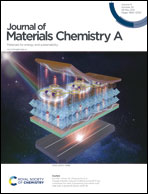Structure-induced partial phase transformation endows hollow TiO2/TiN heterostructure fibers stacked with nanosheet arrays with extraordinary sodium storage performance†
Abstract
The construction of a heterointerface by structure-induced partial phase transformation is an effective strategy to synchronously boost conductivity and regulate the ion diffusion kinetics of TiO2 considered as an anode material for sodium ion batteries. However, construction of a highly conductive heterostructure in well-crystallized TiO2 is still a great challenge. Herein, a structure-induced partial phase transformation method is reported to synthesize hierarchical hollow TiO2/TiN heterostructure fibers (HTTFs) with a high specific surface area for use as an anode. The interfacial effect of the heterostructures for the anode materials could improve charge transfer capability. The improvement of the conductivity is due to the electric field generated inside the nanocrystals, which greatly reduces the ion diffusion resistance of nanocrystals and promotes the interfacial electron transport. Density functional theory calculations and experimental results demonstrate that HTTFs greatly facilitated the mobility of holes and ion diffusion, which result in excellent rate capability (270.9 and 113.1 mA h g−1 at 50 and 10 000 mA g−1, respectively) and excellent cycling stability (132.5 mA h g−1 with an average capacity fading of only 0.002% per cycle at 5000 mA g−1 over 10 000 cycles). Such improvements signify that suitable heterogeneous interface design provides an innovative and versatile approach for achieving advanced battery materials.



 Please wait while we load your content...
Please wait while we load your content...